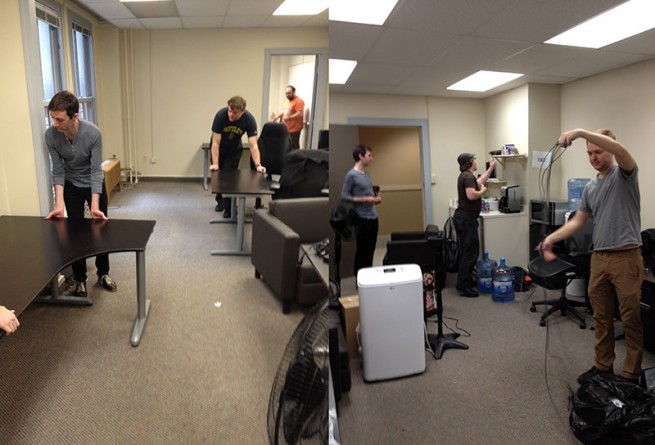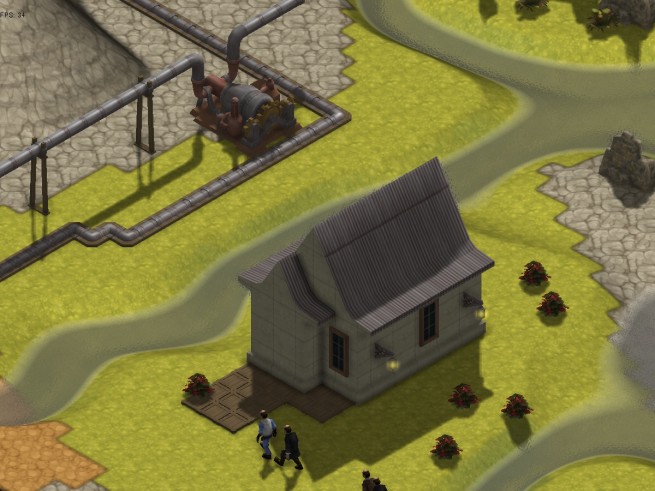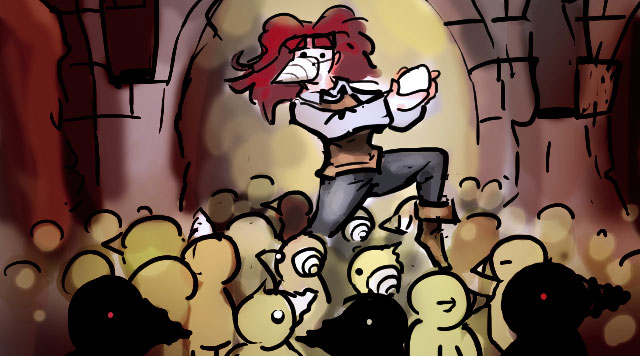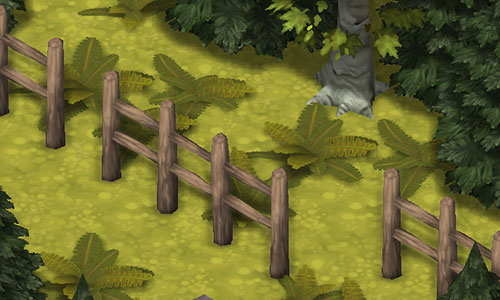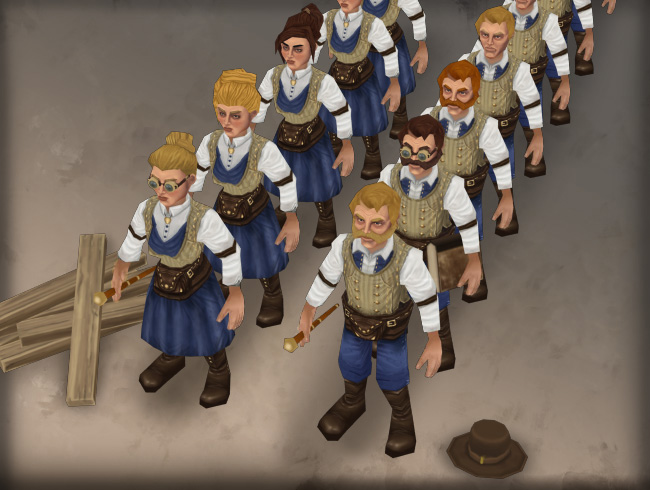You will be glad to know that we all survived a) the Gaslamp Games Christmas Party, and b) the Snowpocalypse in Vancouver, with only minor cases of frostbite and damage to clothing. However, this has made today’s blogpost a bit on the late side and we apologize. People have wanted to hear about this for awhile, so as a special treat – let’s look at Clockwork Empires’ dynamic music system.
Dynamic Music
20 Comments
Flora
Generating terrain for a video game is almost always done by hand, by artists, over a long period of time, sometimes even going to the lengths of placing each blade of grass that the player will see. This visual design and implementation of large scale AAA video games is the vast majority of their development budgets, spanning tens of millions of dollars that we obviously don’t have.
So we don’t do it that way. We can’t compete with it. Instead, we (like many other indie game companies) cut corners by making the game world generate itself procedurally, writing algorithms for the placement of trees, grass, rocks, rivers, mountains, glowing ruins and evil monoliths. Seriously, we have an algorithm for evil monoliths.

The Gray Man can be found among the giant horsetails on only the blackest nights when even the moon itself hides itself away from What Which Walks. No, this is something far more sinister than a quick asset scale test render in Maya.
David and I have been arguing since the last post on game terrain about the “binning” of our biomes into the 9 categories. His argument being that it’s an unnecessarily simplistic system for such a potentially rich environment. My argument was, of course, that at some point the simulation is growing so intricate that we’re spending time where we shouldn’t be, and that we’d be far better off improving the game-play than the terrain, but if we’re doing things right, the game-play will be pretty heavily influenced by the terrain, so a certain amount of this makes sense.
So I have capitulated, may the internet have mercy on me. Here’s how the system works right now. (If you don’t think that math functions are cool, this might be a little dry. Sorry about that!)
22 Comments
All The Peoples (and an interview)
Regarding my note in the Putting People Together post from last month, Joseph’s been busy painting up a variety of skin tones for Clockwork Empires people.
17 Comments
Oh Good! We’re on Sale Again!
It’s finally happened. We have seen the signs in the bones, and in the hearts of trees themselves. The augury is complete, and we have know the signs – and they know us.
The Steam Autumnal Sale is upon us, and Brax the Salesdemon has gone insane with MERCANTILE POWER.
Right now, Dredmor Complete can be yours for only $2.49.
Individual Expansion Packs can be yours for $0.74.
STOP HIM BEFORE HE CUTS PRICES AGAIN OH NO THE HORROR –
10 Comments
It’s an Odd World After All
It’s amazing how far you can go writing a video game without actually answering really important questions like “how does the game terrain actually work?” In a perfect world, if everything worked as you imagined it would the first time, making video games (on our time scale at least) involves spending a few months building the idea of the game in your head, then spending a year or so whittling each piece out of little wooden blocks and pressing them gently into the computer. This has the added advantage of explaining why our computers are filled with little wooden blocks.
We’re writing the biome code now (well, another iteration of it) which determines what natural objects exist in what areas, be they desert, tundra, jungle, forest, or maybe something weird like an Healthfully Irradiated crater or a la(r)va field, who knows.
There’s a bit of a process to defining how these things exist, what they get to talk to, and how complicated we want to make them: We hammer out a 3 page document on our internal wiki, argue over it (possibly in THE PIT), make Perfectly Necessary Amputations in some places, and more complexity in others, then start actually writing code. Invariably we’ll forget something or make a Horrible Mistake that causes the world to be impaled with giant spikes of rock that are infinitely tall (it happens) and have to rewrite, but that’s the Creative Process.
Every game tile is currently given a temperature & humidity value, a wateriness descriptor (aquatic, wetland, or land), and an integer value for soil quality. We started with a simple 3×3 matrix of temperature and humidity numbers to map biomes on, but it turned we really wanted swamps because they’re 1. creepy and 2. you need somewhere quiet to throw that body or that artifact which Was Never Meant To Be Found. Similarly, we’d like rich, rolling prairies to cleanse of wild aurochs herds and fill with factories and pipes, and because there was no distinction in our system between the temperature/humidity values of forests and grassland areas, we realized there was a need for some measure of soil quality. In broad terms for our system, fertile soil produces trees and barren soil produces grasses – or nothing at all.
This notion of soil quality may also give an interesting mechanical and ethical/narrative consideration to the act of (profitable, profitable) deforestation.
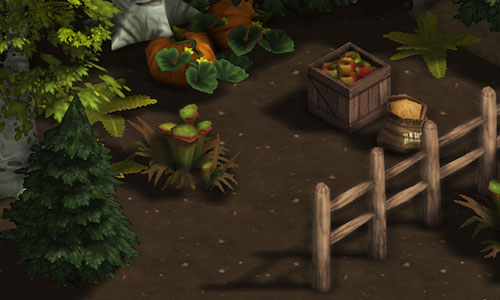
Don’t eat the apples in the Garden of Potemkin. (And yes, there’s another little fence. I like the fence. Deal with it.)
With this fertility numeric, we can do all sorts of neat things: We can make clear-cutting a forest cause the area over time to yield no trees at all; We can give incentive for crop rotations (if we want to be bothered with that), or we can give you a temporary bonus for, say, slashing/burning jungles by temporarily boosting the soil fertility drastically. Sure, all the animals would die, the area would become a barren wasteland after just a few crops as the topsoil was washed away, and you’d be left with useless land and starving peasants, but that’s okay because you’ve put enough away cash from skimming off the opium plantations to retire your bureaucrat to that manor in the Home Counties, right?
It will of course need to be clear to players what the impact of these choices will be, and you should still be able to just render your terrain a hellish landscape of coal factories (which make coal out of other types of coal) and machinery, each attended by noble clusterings of pipe, but making the hard choices that balance quality of life – and the landscape – with short-term needs (Dagon isn’t going to drive himself back into the swirling blackness of the ocean depths) should make the world feel like more than just a grid to build stuff on.
23 Comments
Putting People Together
We’ve been playing our cards pretty close to the chest here at Gaslamp Games when it comes to showing final game assets. You know, put your best foot forward and make a good impression and all that. There were some scenes showing rendered assets (not in-engine) shown in the PC Gamer preview but we have since overhauled much of what was shown there. For today, let us focus on the characters.
Our character artist here at Gaslamp Games, Gentleman Joseph, has been very, very busy.
22 Comments


